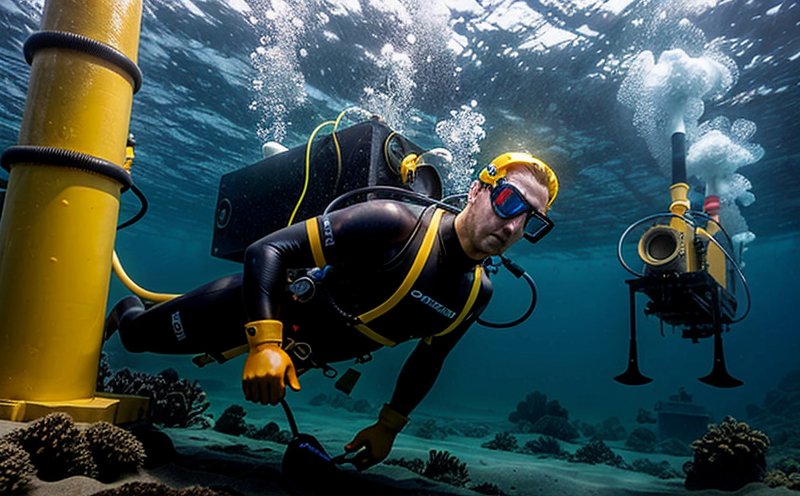ISO 16831 Ultrasonic Testing of Composite Subsea Components
The ISO 16831 standard specifies methods for ultrasonic testing (UT) of composite materials, which are widely used in the design and manufacturing of subsea equipment. This service ensures that these components meet stringent quality standards before deployment in harsh marine environments. The testing process involves examining composite parts using ultrasonic waves to detect flaws or defects without compromising the integrity of the material.
Composite materials are preferred for their lightweight, corrosion-resistant properties and high strength-to-weight ratios, making them ideal for subsea applications where durability and reliability are crucial. However, these materials can be susceptible to manufacturing defects such as delamination, voids, or imperfections in the resin matrix. ISO 16831 provides a robust framework for identifying these issues early on.
The testing procedure typically involves preparing the composite component by cleaning and positioning it correctly within the ultrasonic testing equipment. The operator then applies coupling agents to ensure efficient transmission of sound waves across interfaces between the probe and the specimen surface. A transducer sends high-frequency sound pulses into the material, which reflect back when they encounter internal boundaries or defects.
The reflected signals are captured by a receiver and displayed on an oscilloscope screen as a waveform trace. Skilled analysts interpret these traces to determine whether any anomalies exist within the tested area. This non-destructive evaluation method allows for continuous monitoring throughout production cycles, ensuring consistency in product quality.
One of the key advantages of ISO 16831 UT is its ability to detect small defects that may not be visible through visual inspection alone. By employing advanced signal processing techniques and specialized software packages, we can achieve highly sensitive detection levels capable of identifying even minute flaws within composite structures.
Another benefit lies in the repeatability aspect; since ultrasonic testing relies on consistent wave propagation characteristics, results from different operators or laboratories should yield similar outcomes when following established procedures. This consistency facilitates better traceability and comparability across projects involving multiple stakeholders.
In addition to detecting defects during manufacturing stages, ISO 16831 UT also plays a vital role in ensuring ongoing maintenance activities meet prescribed standards. Regular inspections using this method help identify signs of degradation over time due to exposure to saltwater or other environmental factors that could compromise the structural integrity of subsea components.
Our laboratory employs state-of-the-art equipment and experienced personnel trained specifically for conducting ISO 16831 UT on composite materials. We adhere strictly to all relevant guidelines set forth by international standards bodies like ISO, ASTM, and EN, ensuring that every test conducted meets the highest level of accuracy and reliability.
To summarize, implementing ISO 16831 ultrasonic testing for composite subsea components offers several significant advantages including improved quality control measures, enhanced safety protocols, reduced downtime during maintenance periods, and increased confidence in product performance under challenging marine conditions. By leveraging this methodology early on in the development process or as part of routine inspections later down the line, organizations can protect their investments while maintaining compliance with regulatory requirements.
| Application Area | Specific Use Case |
|---|---|
| Offshore Oil & Gas | Testing riser pipes and flowlines for integrity. |
| Marine Engineering | Evaluating hull structures and propellers against corrosion risks. |
| Naval Defense | Inspecting sonar domes and other underwater systems for operational reliability. |
| Underwater Construction | Detecting flaws in mooring chains and anchors used during installation projects. |
Benefits
Implementing ISO 16831 ultrasonic testing brings numerous benefits to companies operating in the marine and ship equipment sectors. One primary advantage is enhanced quality assurance, which translates into safer operations at sea by reducing the risk of catastrophic failures caused by undetected defects.
This service also contributes significantly towards maintaining regulatory compliance with strict maritime regulations such as those enforced by international bodies like IMO (International Maritime Organization). By adhering to these standards through rigorous testing practices, businesses can avoid potential penalties and reputational damage associated with non-conformance.
Moreover, ISO 16831 UT helps optimize resource allocation by allowing precise identification of problematic areas within composite components. This targeted approach ensures that limited repair budgets are spent effectively on critical parts rather than addressing hypothetical issues across entire assemblies.
The reliability gained from consistent testing procedures fosters trust among customers and partners, thereby strengthening business relationships and opening doors for future collaboration opportunities. Additionally, the ability to provide transparent documentation supporting test results enhances customer satisfaction and confidence in purchased products or services.
International Acceptance and Recognition
The ISO 16831 standard enjoys widespread acceptance globally due to its comprehensive approach towards ensuring the quality of composite materials used in subsea applications. Many leading manufacturers and operators within the marine industry recognize this standard as a benchmark for excellence.
For instance, major oil companies like BP and Shell have incorporated ISO 16831 UT into their procurement processes to verify the integrity of critical components supplied by suppliers worldwide. Similarly, naval organizations such as NATO and various national navies mandate compliance with this standard when specifying subsea equipment for military operations.
Government agencies responsible for overseeing offshore activities also frequently reference ISO 16831 in their guidelines and directives. This recognition underscores the importance placed on using reliable testing methods that guarantee consistent results across diverse environments and applications.
In addition to governmental endorsement, numerous professional associations and trade groups advocate for adherence to this standard among their members. By aligning with these best practices, organizations can position themselves as leaders in quality assurance, attracting more business partners and clients who value stringent testing protocols.





